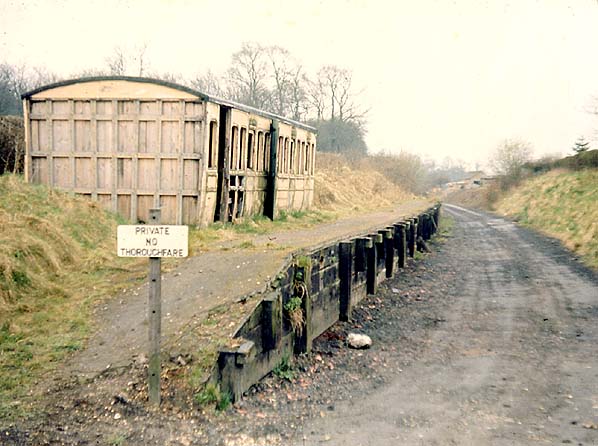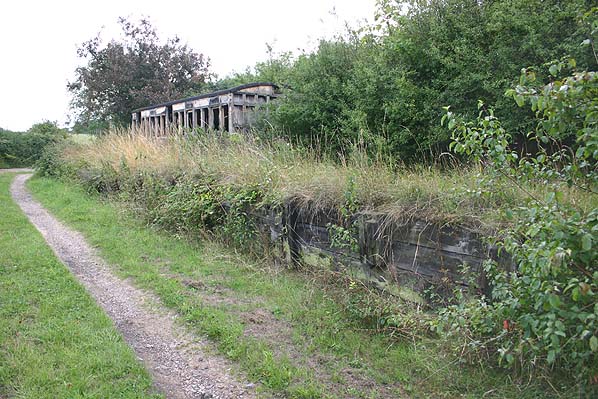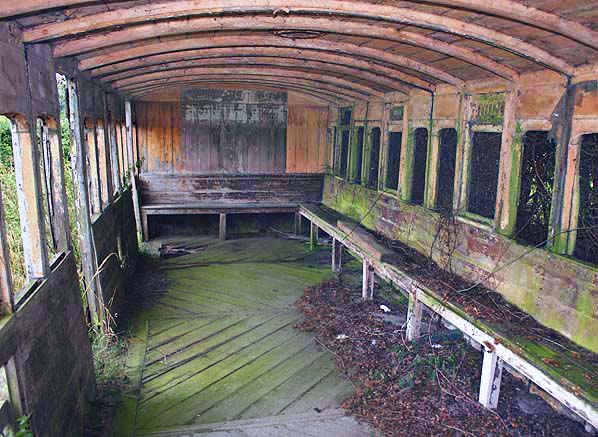
Station Name: ASHDON HALTAshdon Halt Gallery 2: 1964 - April 2015 halt_old9.jpg) Diesel railbus E79961 at Ashdon Halt at Ashdon Halt probably in 1964 just prior to closure, by which time the railbuses had been given warning flashes in either the offside windscreen or the corner curved light. Anecdotes say the Saffron Walden - Bartlow - Haverhill section was lightly used and railbuses often ran empty. Perhaps this was true at certain times of the day but photographic evidence, as above, usually shows some passengers on board. Immediately behind the railbus is Fallowden Lane level crossing which led to the halt from Church End, the actual location of Ashdon Halt. Fallowden Lane was the only public level crossing on the branch. Beyond the halt Wiseman's occupation crossing can be seen. The running-in board is now an Eastern Region blue enamel type. Note that the full title has been given. Across the network, the inclusion of 'Halt' was arbitrary in pre-nationalisation days but, with the notable exception of the North Eastern Region, BR was rather fond of the word and often included it on totems as well as on running-in boards. The platform lamp is minus its burner, probably removed for maintenance. The casement hood is identical to that installed at Worlington on the Mildenhall branch. In studying photographs of Ashdon Halt, sharp-eyed readers may notice the lamp casements were swapped around from time to time. There were probably removed for cleaning and replaced in no particular order. The ladder seems to have been a permanent resident during BR days and some photographs show two. As with the oil lamps, one might think that these items would mysteriously disappear but petty crime at remote rural locations was virtually unheard of in those days.
Photo from Jim Lake collection halt_old10.jpg) On 5 September 1964 E79961 stands at Ashdon Halt with a service to Bartlow, despite the contradictory destination blind. Some drivers, evidence suggests, tended to leave Audley End on one end and Saffron Walden on the other irrespective of actual destination. The lady with the dress apparently made from a Gingham tablecloth, and who is probably in charge of the perambulator on the platform, is no doubt taking a photograph for posterity as this was the penultimate day of the branch passenger service. The lamp on the platform is undergoing maintenance. The oil drum may simply be abandoned or it could be in use to store paraffin for the platform lamps. Later that day E79961 would be changed over with E79963 and the latter would work the final services on the branch the following day. E79961 was the only one of the five German railbuses not to survive, being scrapped by C F Booth, Rotherham, in 1967. Prior to withdrawal, and when some of the railbuses were effectively dumped out of use at Cambridge, they were inspected by the Dover Harbour authorities for possible use on their system but ultimately it was decided that the vehicles did not fit the bill. The contrast between Ashdon Halt and Dover Harbour could not have been greater.
Photo by Peter Paye
 Ashdon Halt looking west in September 1969, a year after the track was lifted. Black-and-white photographs suggest that the carriage body was painted an off-white colour but the above colour photograph suggests a shade of cream. If so, it was probably the same shade as was widely applied to metal railings at and around stations in the region.
Photo by Nick Catford halt13.jpg)
The remains of Ashdon Halt in 1975, eleven years after closure and seven years after the track was lifted. The trackbed has become a private access road, albeit a somewhat waterlogged one. One of the original doors is now missing while the 'shed door' is now off its hinges and leaning against the body. It is surprising how railway equipment of all types deteriorates rapidly once use and maintenance stops but the missing parts, particularly the entire end panelling, were likely to have been deliberately removed for firewood or some other domestic purpose. Notwithstanding this, forty years on the basic structure still stood, and no doubt helped by the roofing felt which had been present long before the branch closed. The clinker platform would also help in that it would provide a degree of drainage.
Photo by David Burrows from his Flickr photostream halt14.jpg) Fallowden Lane level crossing on the same wet day in 1975. The gates have gone but the substantial gate posts are still there.
Photo by David Burrows from his Flickr photostream 
Ashdon
Halt in August 2005; nature has taken over the platform but little else has changed.
Photo by Nick Catford  Inside the 'waiting room', a converted GER carriage Ashdon Halt looking north in August 2005. The internal fittings were stripped out and wooden benches fitted around the sides, Photo by Nick Catford halt16.jpg) A close-up of the carriage body in October 2007. Apart from the sign, little has changed since 1975 and even some of the beading is still present along with three of the ventilators. The framework, at least that at the near end, still appears to be fairly solid and the roofing felt is still present.
Photo by Ed Greenaway from his Ashdon Halt Flickr photostream halt17.jpg) Ashdon Halt looking towards Bartlow in October 2007. Nature's input and the use of the trackbed as a driveway has left the impression of the former railway curving sharply to the right beyond the platform. In fact the railway ran more or less directly ahead and the bushes in the background have grown along the north side of Fallowden Lane and across the trackbed. On the ground there is no trace of the railway or Wiseman's crossing in the field on the other side of the bushes
Photo by Ed Greenaway from his Ashdon Halt Flickr photostream halt18.jpg) A close-up of the crumbling platform edge at Ashdon in October 2007. Faced with old sleepers and stanchions from the same source, the platform is said to have been of compacted earth with an ash and clinker surface. Over time, this type of surface would take on a hard and durable composition almost like a crude cement, but to trip and fall onto it was not recommended as it was very abrasive. What appears to be an old rail spike has worked its way out of the platform face. This type of spike was found on early flat-bottom track (Vignoles rail) and on narrow gauge railways, but how this particular spike found its way to Ashdon is anybody's guess.
Photo by Ed Greenaway from his Ashdon Halt Flickr photostream halt19.jpg) Ashdon Halt looking south-east in December 2013.
Photo by Norman Shepherd halt20.jpg) Ashdon Halt in April 2015 with dilapidation now the order of the day. The platform is now collapsing but when considering it was timber-faced earth and clinker it is perhaps amazing it has lasted this length of time. Disuse has prevailed for over half a century but the timbers visible above do not appear to be suffering from rot to any great extent. The carriage body is not as bad as it appears at first glance. Much of the outer panelling has now gone but there is no sign of impending collapse, suggesting the framework remains fairly sturdy. One, perhaps two, of the louvred ventilators above the doors are still present as are at least two door droplight frames. No doubt the roofing felt and reasonably sheltered location have helped delay the decay. Behind the carriage body some blossom and green shoots of springtime are adding a splash of colour but no railbus will ever call here again to allow its passengers to sample the quaint delights of this rural halt. The carriage body, however, could one day carry passengers again. After all, certain heritage railways have done a spendid job of retrieving and restoring ancient and dilapidated grounded bodies such as that at Ashdon.
Photo from Kitmasterbloke Flickr Photostream
 Home
Page Home
Page
|

halt_thumb15.jpg)








